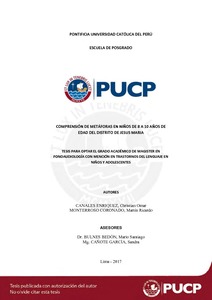| dc.contributor.advisor | Bulnes Bedón, Mario Santiago | |
| dc.contributor.advisor | Cañote García, Sandra | |
| dc.contributor.author | Canales Enriquez, Christian Omar | es_ES |
| dc.contributor.author | Monterroso Coronado, Martín Ricardo | es_ES |
| dc.date.accessioned | 2018-01-31T19:36:27Z | es_ES |
| dc.date.available | 2018-01-31T19:36:27Z | es_ES |
| dc.date.created | 2017 | es_ES |
| dc.date.issued | 2018-01-31 | es_ES |
| dc.identifier.uri | http://hdl.handle.net/20.500.12404/9971 | |
| dc.description.abstract | La tesis tiene un objetivo descriptivo y se basa en la relación indisoluble
entre el pensamiento y lenguaje. La población estudiada corresponde al distrito de
Jesús María de Lima (08 años y 10 años 11 meses), con 407 participantes de un
colegio particular y otro parroquial. Para evaluar la comprensión de metáforas se
construyó y procesó psicométricamente la prueba COMMETA. Encontrándose
que los niños de 08 años responden correctamente al 71,9% de las preguntas, los
de 09 años al 77,8% y los de 10 años al 87%. Así se establece parámetros de
normalidad en niños neurotípicos entre los 08 y 10 años. Se concluye que la
comprensión de metáforas mejora con la edad dependiendo, en mayor medida, de
la función semiótica, pero también del desarrollo semántico, la competencia
comunicativa y la interacción con el entorno. | es_ES |
| dc.description.abstract | The thesis has a descriptive objective and is based on the indissoluble
relationship between thought and language. The population studied corresponds to
the district of Jesús María de Lima (08 years and 10 years and 11 months), with
407 participants from a private school and another parochial school. To evaluate
the understanding of metaphors the COMMETA test was constructed and
processed psychometrically. Finding that the children of 08 years respond
correctly to 71.9% of the questions, those from 09 years to 77.8% and those from
10 years to 87%. This establishes normality parameters in neurotypical children
between 08 and 10 years. It is concluded that the understanding of metaphors
improves with age depending, to a greater extent, on the semiotic function, but
also on semantic development, communicative competence and interaction with
the environment. | es_ES |
| dc.language.iso | spa | es_ES |
| dc.publisher | Pontificia Universidad Católica del Perú | es_ES |
| dc.rights | Atribución-NoComercial-SinDerivadas 2.5 Perú | * |
| dc.rights | info:eu-repo/semantics/openAccess | es_ES |
| dc.rights.uri | http://creativecommons.org/licenses/by-nc-nd/2.5/pe/ | * |
| dc.subject | Metáfora | es_ES |
| dc.subject | Niños--Lenguaje | es_ES |
| dc.title | Comprensión de metáforas en niños de 8 a 10 años de edad del distrito de Jesús María | es_ES |
| dc.type | info:eu-repo/semantics/masterThesis | es_ES |
| thesis.degree.name | Magíster en Fonoaudiología con mención en Trastornos del Lenguaje en Niños y Adolescentes | es_ES |
| thesis.degree.level | Maestría | es_ES |
| thesis.degree.grantor | Pontificia Universidad Católica del Perú. Escuela de Posgrado | es_ES |
| thesis.degree.discipline | Fonoaudiología con mención en Trastornos del Lenguaje en Niños y Adolescentes | es_ES |
| renati.advisor.dni | 08258705 | |
| renati.discipline | 916137 | es_ES |
| renati.level | https://purl.org/pe-repo/renati/level#maestro | es_ES |
| renati.type | http://purl.org/pe-repo/renati/type#tesis | es_ES |
| dc.publisher.country | PE | es_ES |
| dc.subject.ocde | https://purl.org/pe-repo/ocde/ford#3.05.03 | es_ES |






